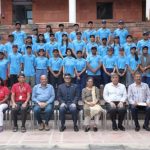It was a night that no official itinerary could have scripted.A senior-most officer from the Ministry of Tribal Affairs, Government of India, arrived in Kashmir to attend the National Tribal Festival in Gurez on August 6th and 7th, 2025. The expected route was simple: Delhi to Srinagar, onward to Bandipora, and then to Gurez — where a government guesthouse or the local Dak Bungalow would await, as protocol dictates.
But this time, the road led to somewhere else.Instead of stopping at official quarters, the dignitary travelled deep into the night to Village Choorwan, a small hamlet perched almost on the Line of Control. There, without fanfare or a curated menu, he stayed in a Log hut House — the traditional home of a Gurez tribal family.
The bed was simple; the food was entirely organic & was cooked in the traditional way. This was not a symbolic photo-op, it was the core idea and heartbeat of the festival: to let the outside world experience Gurez’s tribal life as it truly is — raw, real, and unvarnished.
This remote yet breathtaking Choorwan village of Gurez Valley played host to a unique confluence of culture, tradition, governance, and human connection. The first of its kind in Gurez, the National Tribal Festival has been organized as a part of “Tribal Village 2030 Vision” of Ministry of Tribal Affairs—a policy roadmap aimed at integrating tribal communities into sustainable development while preserving their distinct identity.
The festivalwas dedicated exclusively to the showcasing of the distinct culture of DardShin Tribe and was quite successful to the extent that it became more than just a cultural event. It became a step towards peacebuilding & public outreach, an exercise in promoting border tourism, and perhaps most remarkably, an example where entire officialdom descended right upto the ground zero to have firsthand account of tribal life and their aspirations.
Senior functionaries from J&K Government, especially from the Department of Tribal Affairs, District Administration, and other dignitaries attended, not from behind podiums or security barricades, but amidst the people, breaking long-standing formal protocols. They sat around bonfires, listened to traditional music, and spoke openly with the youth, absorbing their aspirations, concerns, and stories.
Choorwan: From Margin to Centre
Choorwan, a village defined by its distinct close geographical proximity to the LoC, carries the weight of history, security anxieties, and the dreams of the people often left on the margins. Against this backdrop, the festival became a living tableau of what peacebuilding can look like, when borders are filled not with tension but with celebrations resonatingwith music, laughter, and open-ended conversations. It symbolised that even the remotest habitations can be part of the growth story. For people of Choorwan, hosting the guests- dignitaries & officers, in their own homes was not just an honour, it was validation that their identity and way of life matter.
Cross-Sectional Cultural Connections
The festival also welcomed tribal groups from far & wide of the country like Gujarat, Assam, and Tamil Nadu. This was not about token cultural displays, but about genuine exchange & exposure, and more precisely about understanding how indigenous resilience, resourcefulness, and art thrive in varied geographies. For Gurez’s younger generation, this exposure offered a sense of connectedness beyond their mountain borders and an affirmation that their traditions are part of a larger national narrative and national integration.
Culture takes Central Stage
For the first time, the vibrant culture and traditions of the Gurez Valley were showcased at such a large scale before a diverse and heterogeneous audience. Earlier, Gurez was primarily known for its breathtaking landscapes, snow-capped mountains, and pristine natural beauty. But this event marked a decisive shift—transforming the focus towards attracting those with a deeper interest in the Valley’s rich cultural heritage, its folk traditions, and its unique way of life. This cultural rebranding is set to be a game-changer for tourism in Gurez, drawing a different class of visitors who seek more than just scenic beauty.
From Tourists to Travelers – Inviting them all
During last few years, Gurez Valley has been successfully brought on the tourism map of the Kashmir and has witnessed huge tourist inflow however it has remained mostly confined as a seasonal stop for tourists seeking panoramic views and adventure sports. Now, the festival aims to appeal to a new category, the dedicated travellers, historians, and cultural explorers, much like the legendary Walter Lawrence, who once described Gurez as “the Kashmir of the Kashmir.” Such travellers are not satisfied with a brief visit; they immerse themselves in the history, stories, and lived experiences of the places they explore. By weaving its heritage into the visitor experience, Gurez positions itself as a destination for meaningful journeys alongside casual sightseeing.
Border Tourism – A Strategic and Cultural Opportunity
The festival also gave a significant push to the idea of border tourism.Promoting border tourism in Gurez, with its unique geographical and historical significance, is not only an economic opportunity but also a way to encourage national integration and showcase life in regions that are often seen through a security lens. This initiative can inspire similar cultural events in other border areas of Jammu & Kashmir, strengthening the integration between remote communities and the national mainstream.
Livelihoods through Cultural Commerce
A vibrant feature of the National Tribal Festival was the array of stalls that transformed the venue into a bustling cultural marketplace. Local artisans proudly displayed Gurez’s renowned handicrafts, handlooms, and handmade goods—treasures celebrated across the country for their craftsmanship.
Alongside these, the valley’s famed agricultural produce such as Gurezi Rajma and Gurezi Potatoes drew wide attention, not only for their taste but also for their potential as unique agri-brands. Adding to the diversity, stalls showcased high-value herbs like Zeera and Sheetkaar, known for both their medicinal and economic worth. This blend of culture and commerce reflected how preserving tradition can open pathways to sustainable livelihoods, providing Gurez’s communities with new opportunities to connect their heritage with wider markets.
Top of Form
Bottom of Form
Way-Forward- Let the Celebrations Continue Across Border Regions
Such festivals must not remain one-off events. They should be organized regularly across all border areas of Jammu & Kashmir, carrying forward the echoes of normalcy, celebration, and cultural pride. Beyond tourism, these events send a powerful message of harmony and reaffirming the identity of these regions as integral parts of India’s cultural and emotional map.
(Author is a Kashmir based educator, writer and poet and can be reached at: [email protected])






